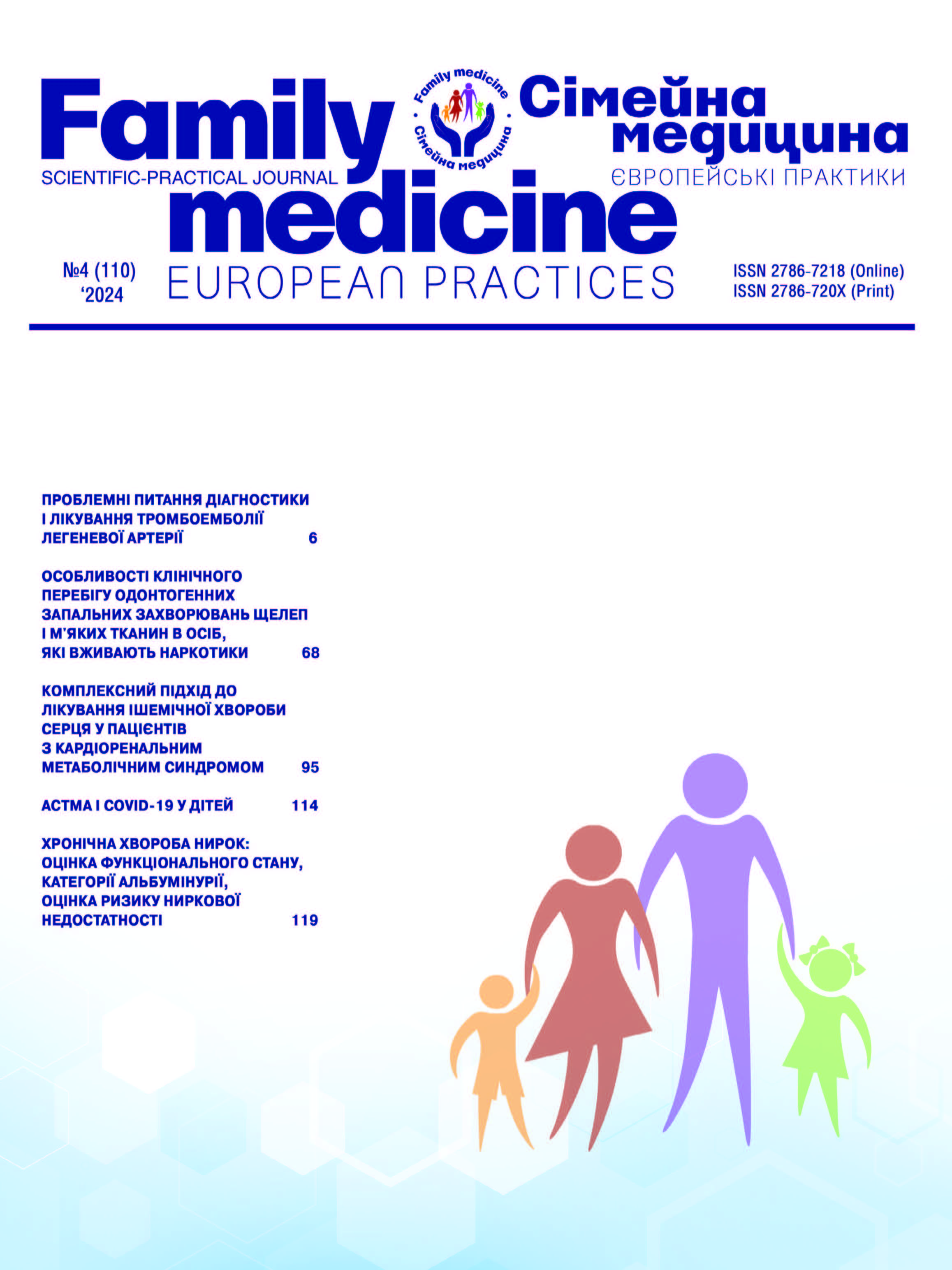Особливості клінічного перебігу одонтогенних запальних захворювань щелеп і м’яких тканин в осіб, які вживають наркотики
##plugins.themes.bootstrap3.article.main##
Анотація
Мета дослідження: аналіз особливостей клінічного перебігу одонтогенних запальних захворювань щелеп та білящелепних м’яких тканин у наркозалежних осіб.
Матеріали та методи. Проведено обстеження та лікування 294 наркозалежних пацієнтів з одонтогенними запальними захворюваннями щелеп та м’яких тканин. Усім хворим проведено загальноприйняте клінічне та рентгенологічне обстеження при зверненні та в динаміці лікування. У хворих виявлено первинні одонтогенні запальні процеси в щелепі, а саме: періодонтит, періостит та остеомієліт.
Достовірність результатів обстеження обчислювали згідно з критеріями Стьюдента. Відмінності вважали достовірними при р < 0,05.
Результати. В учасників дослідження виявлені атипові клініко-рентгенологічні особливості перебігу періодонтитів, періоститів, остеомієлітів, абсцесів та флегмон, а саме: прогресуючий характер, значна поширеність ураження, своєрідна клінічна симптоматика. У наркозалежних осіб відзначено незадовільне загоєння постекстракційних і післяопераційних ран, дуже низьку ефективність проведених лікувальних заходів, рецидивний перебіг, що слід враховувати під час лікування даної категорії хворих.
Висновки. Розроблені схеми лікування одонтогенних гнійно-запальних захворювань м’яких тканин щелепно-лицьової ділянки та шиї у наркозалежних осіб сприяють швидшій ліквідації гнійно-запального процесу (порівняно з традиційним лікуванням), покращують загоєння післяопераційних гнійних ран та скорочують виникнення місцевих післяопераційних запальних ускладнень у 3–4 рази.
##plugins.themes.bootstrap3.article.details##

Ця робота ліцензується відповідно до Creative Commons Attribution 4.0 International License.
Автори зберігають авторське право, а також надають журналу право першого опублікування оригінальних наукових статей на умовах ліцензії Creative Commons Attribution 4.0 International License, що дозволяє іншим розповсюджувати роботу з визнанням авторства твору та першої публікації в цьому журналі.
Посилання
Yazdanian M, Armoon B, Noroozi A, Mohammadi R, Bayat AH, Ahounbar E, et al. Dental caries and periodontal disease among people who use drugs: a systematic review and meta-analysis. BMC Oral Health. 2020;20(1):44. doi: 10.1186/s12903-020-1010-3.
Sosyn IK, Goncharova EY, Chuev YuF. Clinical and diagnostic algorithms of opioid dependence. East Eur J Internal Fam Med. 2017;(1):17–22.
Bugorkova IA. The prevalence of dental diseases in drug-addicted patients for the development of a risk reduction program. Ukr Health Nation. 2015;34(2):28–30.
Al Bush MM. An oral cavity profile in illicit-Drug abusers? J Indian Soc Periodontol. 2019;23(6):517–24. doi: 10.4103/jisp.jisp_716_18.
Fedun IR, Furdychenko AI, Ilchishin MP. Baryliak AYa, Han IV, Voznyi OV, et al. Influence of drug addiction on oral pathology and peculiarities of stomatologic assistance to drug dependent patients (literature review). Zaporizhzhya Med J. 2020;123(6):858–64. doi: 10.14739/2310-1210.2020.6. 218473.
Kostenko EA, Foros AI. Analysis of changes in dental status in patients with drug addiction. Modern Dent. 2016;(2):120–3.
Owlia F, Karbassi MHA, Sadeghipour M, Behnia A. Evaluating of Cervical Caries and Periodontitis among Drug Abusers in an Iranian Population. Ann Res Rev Biol. 2017;12(3):1–8. doi: 10.9734/ARBB/2017/31183.
Saied-Moallemi Z, Taheri A, Hatami H. Investigating the relation of drug abusing and oral health in addicts. J Isfahan Med Schoоl. 2015;33(333):643–52.
Hossain KMS, Kakoli AS, Mesbah FB, Mian AH. Prevalence of Oral and Dental Diseases and Oral Hygiene Practices among Illicit Drug Abusers. J Alcohol Drug Depend. 2018;6(1):301. doi: 10.4172/2329-6488.1000301.
Saini GK, Gupta ND, Prabhat KC. Drug addiction and periodontal diseases. J Indian Soc Periodontol. 2013;17(5):587–91. doi: 10.4103/0972-124x.119277.
Shekarchizadeh H, Khami MR, Mohebbi SZ, Ekhtiari H, Virtanen JI. Oral health status and its determinants among opiate dependents: a cross-sectional study. BMC Oral Health. 2019;19(1):5. doi: 10.1186/s12903-018-0691-3.
Albertson TE. Specific poisons and drugs: diagnosis and treatment. Opiates and opioids. In: Kent O., editor. Poisoning and drug overdose. 6th ed. New York: McCraw – Hill Companies, Inc.; 2012, p. 301–12.
Nittayanta W, Jealae S, Winn T. Oral Canadian HIV-infected heterosexuals and intravenous drug users Thailand. J Oral Pathol Med. 2002;30:347–54. doi: 10.1034/j.1600-0714.2001.300604.X.
Du M, Bedi R, Guo L, Champion J, Fan M, Holt R. Oral health status of heroin users in a rehabilitation centre in Hubei province, China. Community Dent Health. 2001;18(2):94–8.
Cook H, Peoples J, Paden M. Management of the oral surgery patient addicted to heroin. J Oral Maxillofac Surg. 1989;47(3):281–5. doi: 10.1016/0278-2391(89)90232-2.
D’Amore MM, Cheng DM, Kressin NR, Jones J, Samet JH, Winter M, et al. Oral health of substance-dependent individuals: impact of specific substances. J Subst Abuse Treat. 2011;41(2):179-85. doi: 10.1016/j.jsat.2011.02.005.
Pradhan A, Slade GD, Spencer AJ. Access to dental care among adults with physical and intellectual disabilities: residence factors. Aust Dent J. 2009;54(3):204–11. doi: 10.1111/j.1834-7819.2009.01120.x.
Reece AS. An intriguing association between dental and mental pathology in addicted and control subjects: a cross-sectional survey. Br Dent J. 2008;205(11):E22. doi: 10.1038/sj.bdj.2008.932.
Timofeev OO. Maxillofacial surgery: textbook – 2nd edition. Kyiv: VSC «Medicine»; 2017, p. 144–353.
Egloff-Juras C, Gallois A, Salleron J, Massard V, Dolivet G, Guillet J, et al. Denosumab-related osteonecrosis of the jaw: A retrospective study. J Oral Pathol Med. 2018;47(1):66–70. doi: 10.1111/jop.12646.
Hamadeh IS, Ngwa BA, Gong Y. Drug induced osteonecrosis of the jaw. Cancer Treat Rev. 2015;41(5):455–64. doi: 10.1016/j.ctrv.2015.04.007.
Booth RE. ‘Krokodil’ and other home-produced drugs for injection: a perspective from Ukraine. Int J Drug Policy. 2013;24(4):277–8. doi: 10.1016/j.drugpo.2013.05.009.
King R, Tanna N, Patel V. Medication-related osteonecrosis of the jaw unrelated to bisphosphonates and denosumab-a review. Oral Surg Oral Med Oral Pathol Oral Radiol. 2019;127(4):289–99. doi: 10.1016/j.oooo.2018.11.012.
Sergent JF, Bader G, Hamong J, Peigne L, Lejeune S. Krokodil (desomorphine) – induced osteonecrosis of the maxilla: a case report and literature review. J Oral Med Oral Surg. 2019;25–6. doi: 10.1051/mbcb/2019011.
Gahr M, Freudenmann RW, Hiemke C, Gunst IM, Connemann BJ, Schönfeldt-Lecuona C. Desomorphine goes «crocodile». J Addict Dis. 2012;31(4):407–12. doi: 10.1080/10550887.2012.735570.
Skowronek R, Celiński R, Chowaniec C. «Crocodile» – new dangerous designer drug of abuse from the East. Clin Toxicol (Phila). 2012;50(4):269. doi: 10.3109/15563650.2012.660574.
Van Hout MC. Kitchen chemistry: A scoping review of the diversionary use of pharmaceuticals for non-medicinal use and home production of drug solutions. Drug Test Anal. 2014;6(7-8):778–87. doi: 10.1002/dta.1622.
van Kempen EEJ, Brand HS. Effects of krokodil (desomorphine) use on oral health – a systematic review. Br Dent J. 2019;227(9):806–12. doi: 10.1038/s41415-019-0854-x.
Hakobyan K, Poghosyan Y. Spontaneous bone formation after mandible segmental resection in «krokodil» drug-related jaw osteonecrosis patient: case report. Oral Maxillofac Surg. 2017;21(2):267–70. doi: 10.1007/s10006-017-0613-6.





